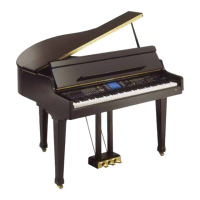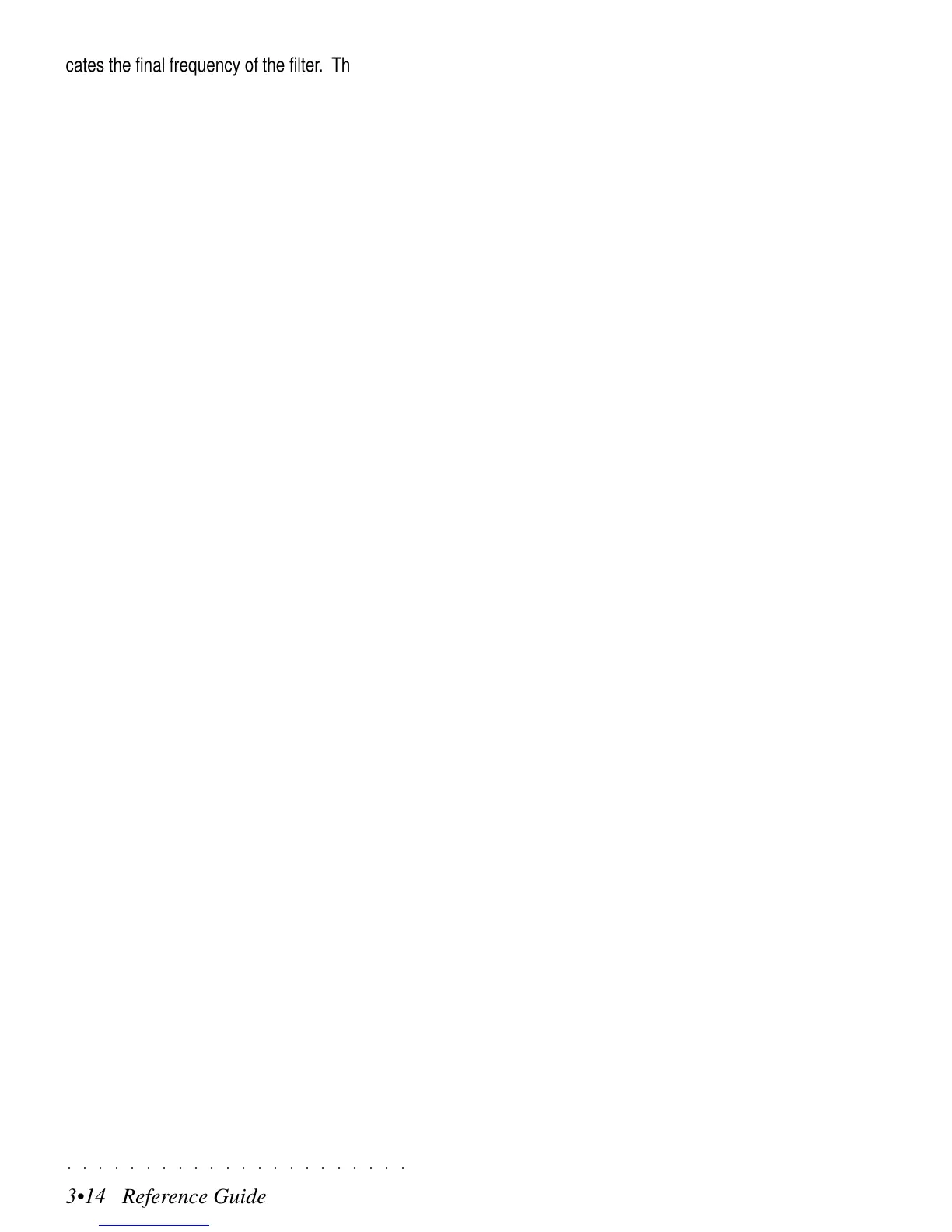○○○○○○○○○○○○○○○○○○○○○○
3•14 Reference Guide
○○○○○○○○○○○○○○○○○○○○○○
3•14 Reference Guide
cates the final frequency of the filter. The decay
of the high frequencies has a longer duration than
that of the low frequencies.
ROOM SIZE: Dimensions of the simulated room.
The time lapse between the first reflection and
the remainder of the reverb.
DIFFUSION: Duration of the reverb (Early type
reverbs).
L.P.FILTER (LOW PASS FILTER): Determines
the cutoff frequency of the filter.
DELAY (DELAYS): Velocity of the delay repeti-
tion.
FEEDBACK (DELAYS): Interaction of the delay
with itself. Determines the number of repetitions
of the delay.
FEEDBACK (PHASERS AND FLANGERS): In-
teraction of the phaser or flanger with itself. De-
termines the harmonic amount of the effect.
FREQ.MODUL. (FREQUENCY MODULATION):
Modulation velocity of chorus and flanger effects.
DEPTH: Depth of the action of the effect.
FEEDBACK (DISTORTION): Saturation of the
distortion.
SPEED (ROTARY EFFECTS): Time required to
pass from slow to fast or vice versa.
ROTARY: Slow/fast velocity.
SEMITONE: Transposition in semitone steps.
DETUNE: Detuning over a range of
±
100 Cents.
LOW GAIN: Enhancement of the low frequen-
cies.
MEDIUM GAIN: Enhancement of the mid fre-
quencies.
HIGH GAIN: Enhancement of the high frequen-
cies.
cates the final frequency of the filter. The decay
of the high frequencies has a longer duration than
that of the low frequencies.
ROOM SIZE: Dimensions of the simulated room.
The time lapse between the first reflection and
the remainder of the reverb.
DIFFUSION: Duration of the reverb (Early type
reverbs).
L.P.FILTER (LOW PASS FILTER): Determines
the cutoff frequency of the filter.
DELAY (DELAYS): Velocity of the delay repeti-
tion.
FEEDBACK (DELAYS): Interaction of the delay
with itself. Determines the number of repetitions
of the delay.
FEEDBACK (PHASERS AND FLANGERS): In-
teraction of the phaser or flanger with itself. De-
termines the harmonic amount of the effect.
FREQ.MODUL. (FREQUENCY MODULATION):
Modulation velocity of chorus and flanger effects.
DEPTH: Depth of the action of the effect.
FEEDBACK (DISTORTION): Saturation of the
distortion.
SPEED (ROTARY EFFECTS): Time required to
pass from slow to fast or vice versa.
ROTARY: Slow/fast velocity.
SEMITONE: Transposition in semitone steps.
DETUNE: Detuning over a range of
±
100 Cents.
LOW GAIN: Enhancement of the low frequen-
cies.
MEDIUM GAIN: Enhancement of the mid fre-
quencies.
HIGH GAIN: Enhancement of the high frequen-
cies.
○○○○○○○○○○○○○○○○○○○○○○
3•14 Reference Guide
○○○○○○○○○○○○○○○○○○○○○○
3•14 Reference Guide
cates the final frequency of the filter. The decay
of the high frequencies has a longer duration than
that of the low frequencies.
ROOM SIZE: Dimensions of the simulated room.
The time lapse between the first reflection and
the remainder of the reverb.
DIFFUSION: Duration of the reverb (Early type
reverbs).
L.P.FILTER (LOW PASS FILTER): Determines
the cutoff frequency of the filter.
DELAY (DELAYS): Velocity of the delay repeti-
tion.
FEEDBACK (DELAYS): Interaction of the delay
with itself. Determines the number of repetitions
of the delay.
FEEDBACK (PHASERS AND FLANGERS): In-
teraction of the phaser or flanger with itself. De-
termines the harmonic amount of the effect.
FREQ.MODUL. (FREQUENCY MODULATION):
Modulation velocity of chorus and flanger effects.
DEPTH: Depth of the action of the effect.
FEEDBACK (DISTORTION): Saturation of the
distortion.
SPEED (ROTARY EFFECTS): Time required to
pass from slow to fast or vice versa.
ROTARY: Slow/fast velocity.
SEMITONE: Transposition in semitone steps.
DETUNE: Detuning over a range of
±
100 Cents.
LOW GAIN: Enhancement of the low frequen-
cies.
MEDIUM GAIN: Enhancement of the mid fre-
quencies.
HIGH GAIN: Enhancement of the high frequen-
cies.
cates the final frequency of the filter. The decay
of the high frequencies has a longer duration than
that of the low frequencies.
ROOM SIZE: Dimensions of the simulated room.
The time lapse between the first reflection and
the remainder of the reverb.
DIFFUSION: Duration of the reverb (Early type
reverbs).
L.P.FILTER (LOW PASS FILTER): Determines
the cutoff frequency of the filter.
DELAY (DELAYS): Velocity of the delay repeti-
tion.
FEEDBACK (DELAYS): Interaction of the delay
with itself. Determines the number of repetitions
of the delay.
FEEDBACK (PHASERS AND FLANGERS): In-
teraction of the phaser or flanger with itself. De-
termines the harmonic amount of the effect.
FREQ.MODUL. (FREQUENCY MODULATION):
Modulation velocity of chorus and flanger effects.
DEPTH: Depth of the action of the effect.
FEEDBACK (DISTORTION): Saturation of the
distortion.
SPEED (ROTARY EFFECTS): Time required to
pass from slow to fast or vice versa.
ROTARY: Slow/fast velocity.
SEMITONE: Transposition in semitone steps.
DETUNE: Detuning over a range of
±
100 Cents.
LOW GAIN: Enhancement of the low frequen-
cies.
MEDIUM GAIN: Enhancement of the mid fre-
quencies.
HIGH GAIN: Enhancement of the high frequen-
cies.

